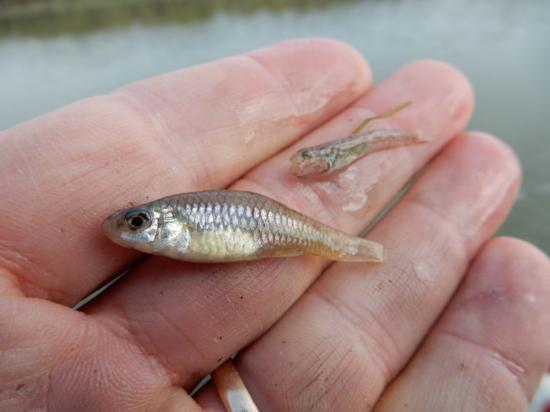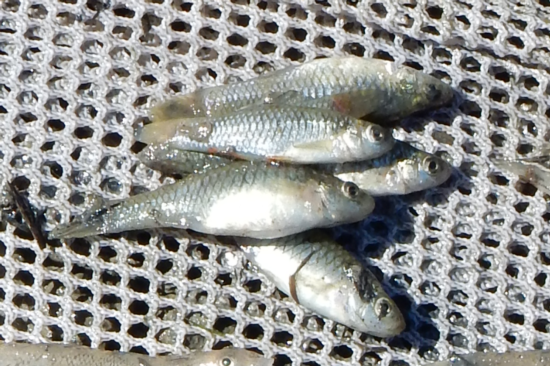Rainwater Killifish
-
Scientific NameLucania parva
-
NativeNo
-
Identification
 Rainwater Killifish (left) caught in Artesian Slough, Santa Clara County, California on 6 November, 2016 by Jim Hobbs. Photo by Jim Ervin.
Rainwater Killifish (left) caught in Artesian Slough, Santa Clara County, California on 6 November, 2016 by Jim Hobbs. Photo by Jim Ervin. Rainwater Killifish caught in Artesian Slough, California on 7 July 2016 by Jim Hobbs. Photo by Jim Ervin.
Rainwater Killifish caught in Artesian Slough, California on 7 July 2016 by Jim Hobbs. Photo by Jim Ervin.- Chunky body
- Rounded dorsal and caudal fins
- Oblique mouth with single row of teeth
- Olive colored on the back with silvery-blue sides and yellow bellies
- 9-14 dorsal, 8-13 anal, 12-18 caudal, 10-15 pectoral, and 4-7 pelvic fin rays
- Males have black on the anterior dorsal fin rays and the edges of the dorsal and anal fins and acquire orange fins and a crosshatch pattern when mating
- Females have a pouch covering the posterior of the anal fin
- 23-29 scales on the lateral line
- Large eyes
-
Life History
Rainwater Killifish are usually found in brackish water and are able to withstand salinities anywhere between 0 ppt and 80 ppt. In California this is most often tidal ditches, channelized ends of inflowing streams, ponds in diked areas, and in streams with unshaded silt bottom pools. They can also be found in shallow salt evaporation ponds with high salinities and dissolved oxygen levels between 2 and 3 mg/L. In most cases this leaves only Western Mosquitofish and Threespine Sticklebacks as companions. Rainwater Killifish will feed on whatever invertebrates are available with younger individuals feeding most commonly on mosquito larvae. As they get larger their diet can diversify making copepods, brine shrimp, and amphipods more common prey items.
Rainwater Killifish can survive in high salinity waters but reproduction is best conducted in salinities below 18 ppt, so while it has not been observed in California, large scale migrations into freshwater are common in the Killifish's native distribution. It is known that the California mating season is between May and July when temperatures are between 17°C and 25°C. Males establish territories above aquatic vegetation beds by fiercely displaying to other males and circling females when they pass through. If a female stops the male will swim underneath her and push up towards the surface. Here they wrap around each other before dropping their fertilized eggs to stick on the vegetation below. This is often a small amount compared to other fish species and females will only lay 10-100 eggs a season. These eggs hatch in about 12 days when temperatures are approximately 24-25°C. The larvae settle to the bottom to feed off their yolk sac for about a week after hatching before joining free-swimming schools under cover of vegetation or in the very shallow water where predation is limited. They will mature in 3-5 months at sizes as small as 25 mm.
-
Links to Other ResearchN / A

